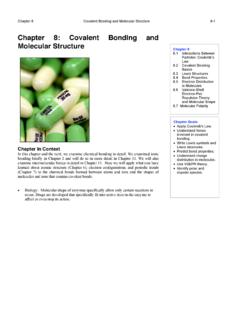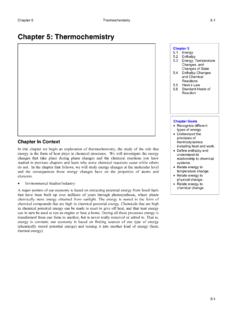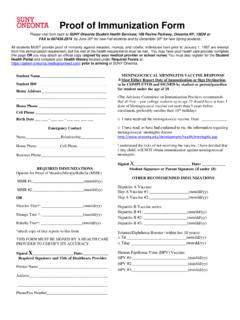Transcription of Chapter 9: Theories of Chemical Bonding - SUNY Oneonta
1 Chapter 9 Theories of Chemical Bonding 9-1 9-1 Chapter 9: Theories of Chemical Bonding Chapter In Context In the previous Chapter we introduced the concept of covalent Bonding . In that description, the VSEPR model uses rules for predicting structures that are based on observations of the geometries of many molecules. In this Chapter we expand this discussion to understand why molecules have these predictable shapes.
2 This deeper understanding involves a model of Chemical Bonding called valence bond theory and will allow us to predict not only expected structures, but also expected exceptions to the usual rules. In the second major part of this Chapter , we examine a second theory of Chemical Bonding , called molecular orbital theory. Molecular orbital theory can be used to explain structures of molecules but also can explain the energetics of Chemical processes, such as what happens when a molecules absorbs a photon of light. In Your World: Photoreceptor molecules in your eyes allow you to see color. These molecules must absorb light in the visible region of the electromagnetic spectrum and undergo some Chemical change when they do.
3 One such molecule, rhodopsin, absorbs light and changes its shape from a cis form to a trans form. The product of this reaction is shaped such that it initiates an electrochemical signal through neurotransmitters to the brain. The key to rhodopsin being an effective photoreceptor is its ability to return over time to the cis form and therefore be able to be used again and again. This ability, we will see in this Chapter , arises because the photon of light breaks one of two bonds connecting two carbon atoms in the molecule. The other bond remains intact and keeps the molecule from completely decomposing. Chapter Goals Identify major bondng Theories . Understand basic tenets of valence bond theory.
4 Supplement valence bond theory with hybrid orbitals. Explain pi Bonding in molecules and ions. Analyze conformations and isomers. Understand basic tenets of molecular orbital theory. Chapter 9 Introduction to Bonding Theories Valence Bond Theory Hybrid Orbitals Pi Bonding Conformations and Isomers Molecular Orbital Theory 9-2 Theories of Chemical Bonding Chapter 9 Introduction to Bonding Theories OWL Opening Exploration As you learned in the previous Chapter (Section ), Chemical bonds form when two atoms approach each other and the attractive forces are greater than the repulsive forces (Figure ).
5 Figure Attractive and repulsive forces between 2 atoms In addition to attractive and repulsive forces and the interatomic distance, Chemical Bonding is also influenced by the shapes of orbitals in atoms and molecules, the number of valence electrons available in the Bonding atoms, and the relative energies of the orbitals involved in bond formation. The two models of Chemical Bonding that address these factors are valence bond theory and molecular orbital theory. Valence bond theory and molecular orbital theory share many assumptions, but also differ in many ways. The two Theories are similar in that both assume that bonds occur due the sharing of electrons between atoms; the attraction of Bonding electrons to the nuclei of the bonded atoms leads to lower energy, and therefore the formation of a bond; and two types of bonds can form (sigma and pi).
6 The two Theories differ in how they describe the location of the electrons in Bonding orbitals, how they explain the energy of electrons, and how they explain the presence of unpaired electrons in molecules. While molecular orbital theory is the more accurate and more broadly useful of the two Theories , valence bond theory is easier to use. For example, valence bond theory predicts shapes of compounds made up of p-block elements. Molecular orbital theory, on the other hand, predicts molecular shapes but only after a more complicated process. Therefore, when discussing the shapes of species made up of p-block elements, chemists invariably use VB theory.
7 When discussing orbital energies, electronic transitions between orbitals, or Bonding in, for example, transition metal compounds, chemists use the more complex molecular orbital theory. At times, the two Theories are used in concert to describe different aspects of Chemical Bonding in a single large molecule. Valence Bond Theory OWL Opening Exploration The basic tenets of valence bond (VB) theory are valence atomic orbitals on adjacent atoms overlap, each pair of overlapping valence orbitals is occupied by two valence electrons to form a Chemical bond, and valence electrons are either involved in Bonding between two atoms (shared Bonding pairs) or reside on a single atom (nonbonding lone pairs).
8 Chapter Goals Revisited Identify major Bonding theoryies Compare and contrast valence bond theory and molecular orbital theory. Chapter Goals Revisited Understand basic tenets of valence bond theory. Explain sigma Bonding using valence bond theory. Chapter 9 Theories of Chemical Bonding 9-3 9-3 A covalent bond is the result of the overlap of orbitals on adjacent atoms. The Bonding region is the location between the atomic nuclei, where electrons occupy the overlapping orbitals.
9 For example, consider the covalent bond in hydrogen, H2 (Figure ). H: 1s Figure The covalent bond in H2 Each H atom has a single unpaired electron in a 1s orbital (H: 1s1). The covalent bond in H2 is the result of the overlap of two 1s atomic orbitals on adjacent H atoms, and each H atom contributes one electron to the covalent bond. The covalent bond forms because of the strong attractive forces between the Bonding electrons in the overlapping region and the two H nuclei. The covalent bond in H2 is a sigma ( ) bond because the Bonding region lies along the internuclear axis, the region of space between the nuclei of the bonded atoms. Sigma bonds are not only formed between two s orbitals.
10 Consider the sigma bond in HF (Figure ). H: 1s F: [He]2s2p Figure The covalent bond in HF Both hydrogen (H: 1s1) and fluorine (F: [He]2s22p5) have an unpaired electron in an atomic orbital. The sigma bond that forms between H and F is the result of overlap of a 1s atomic orbital (on H) with a 2p atomic orbital (on F). Each atom contributes one electron to the covalent bond. The H F bond is a sigma bond because the Bonding region lies between the H and F nuclei. The sigma bond in F2 is the result of overlap of two 2p atomic orbitals, one from each F atom (Figure ). Each F atom contributes one electron to the covalent bond.



















